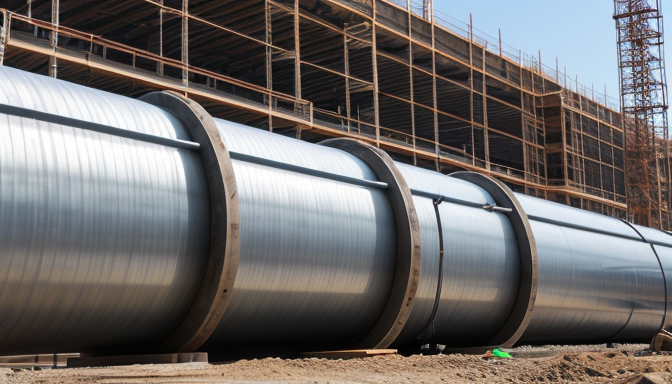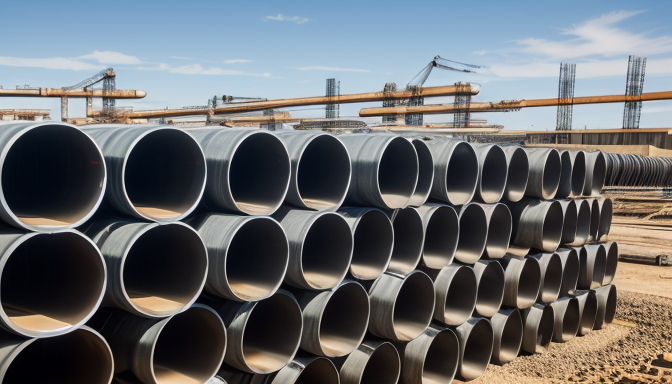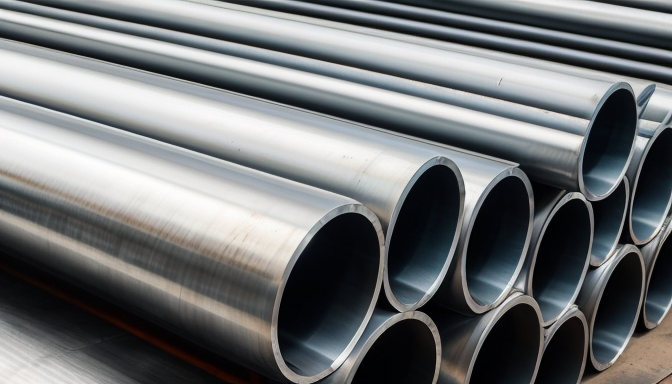S235 steel pipes are a fundamental component in the world of construction and manufacturing. They are known for their strength and versatility, making them a popular choice across various industries. But what exactly makes these pipes so essential? Let’s dive into the core aspects of S235 steel pipes, including their price, weight, properties, sizes, and uses.
Understanding the pricing of S235 steel pipes is crucial for budgeting in construction and manufacturing projects. The price can vary significantly based on several factors:
- Market demand: When demand spikes, prices often follow suit.
- Quality and specifications: Higher quality or specialized pipes tend to cost more.
- Supplier and location: Prices can differ based on where you buy them.
Keeping an eye on current market trends can help you make informed decisions. Regularly checking with suppliers or industry reports can give you a clearer picture of what to expect.
The weight of S235 steel pipes is another important consideration. It affects not only transportation costs but also installation processes. Generally, the weight is determined by the pipe’s dimensions and thickness. For instance, a thicker pipe will naturally weigh more. Here’s a simple breakdown:
| Diameter (mm) | Wall Thickness (mm) | Weight (kg/m) |
|---|---|---|
| 50 | 3 | 3.85 |
| 100 | 5 | 7.85 |
| 150 | 6 | 11.44 |
Knowing the weight of the pipes you plan to use can save you time and money, especially when it comes to logistics.
S235 steel pipes possess specific mechanical properties that make them suitable for various applications. Key characteristics include:
- Yield Strength: This is the stress at which a material begins to deform permanently. For S235 steel, the yield strength is typically around 235 MPa.
- Tensile Strength: This measures the force required to pull something to the point of breaking. S235 steel offers a tensile strength of about 360-510 MPa.
- Durability: These pipes are designed to withstand harsh conditions, making them ideal for outdoor use.
These properties make S235 steel pipes a reliable choice for many construction projects.
S235 steel pipes come in a range of sizes to meet different project requirements. Standard dimensions usually include diameters from 15 mm to 300 mm. Depending on the application, you might choose:
- Small diameter pipes for plumbing
- Larger pipes for structural support
Choosing the right size is crucial for ensuring the integrity and functionality of your project.
The versatility of S235 steel pipes allows for their use in numerous applications. Common uses include:
- Construction: Used in buildings and infrastructure.
- Manufacturing: Integral in producing machinery and equipment.
- Infrastructure: Essential for pipelines and transportation systems.
In summary, S235 steel pipes are a vital part of various sectors, providing strength and reliability. Understanding their price, weight, properties, sizes, and uses can make a significant difference in your projects.
S235 Steel Pipe Price
Understanding the pricing of S235 steel pipes is crucial for anyone involved in construction or manufacturing projects. Why? Because the cost can significantly impact your budget. Various factors influence the price of these pipes, and being aware of them can help you make informed decisions.
First off, the market demand plays a pivotal role. When demand is high, prices tend to rise. Conversely, during periods of low demand, prices may drop. It’s a bit like the weather; sometimes it’s sunny, and sometimes it rains. You need to keep an eye on market trends.
Another factor is the raw material costs. The price of steel fluctuates based on global market conditions. If steel becomes more expensive, you can expect the price of S235 pipes to follow suit. It’s essential to stay updated on these changes. For instance, if you’re planning a large project, buying in bulk when prices are low can save you a ton of money.
Additionally, the pipe dimensions and thickness also affect pricing. Larger and thicker pipes generally cost more. Here’s a quick look at how size can impact price:
| Pipe Diameter (mm) | Price Range ($ per meter) |
|---|---|
| 50 | 10 – 15 |
| 100 | 20 – 30 |
| 150 | 30 – 45 |
Shipping costs are another aspect to consider. If you’re ordering from a supplier far away, transportation fees can add up quickly. It’s like ordering a pizza from across town; you might love the pizza, but delivery fees can make it pricey.
Lastly, don’t forget about supplier pricing strategies. Different suppliers may have varying prices for the same product. It’s always a good idea to shop around. Compare quotes, and don’t hesitate to negotiate. You might just find a better deal that fits your budget.
In summary, several factors influence the price of S235 steel pipes including market demand, raw material costs, dimensions, shipping, and supplier strategies. By keeping these in mind, you can navigate the pricing landscape more effectively and make choices that benefit your projects.

S235 Steel Pipe Weight
When it comes to construction and manufacturing, understanding the weight of S235 steel pipes is absolutely essential. Why? Because weight affects everything from transportation to installation. Imagine trying to lift a heavy pipe without knowing how much it weighs. It could turn into a real hassle! So, let’s break it down.
The weight of S235 steel pipes varies based on their dimensions and thickness. Generally, heavier pipes are more durable, but they can also be more challenging to handle. For example, a thicker pipe might provide better strength but will also weigh more. This balance is crucial for engineers and builders who need to consider both strength and manageability.
To give you a clearer picture, let’s look at some typical weights for common sizes of S235 steel pipes. Here’s a simple table:
| Pipe Diameter (mm) | Wall Thickness (mm) | Weight (kg/m) |
|---|---|---|
| 50 | 3 | 5.70 |
| 100 | 4 | 10.68 |
| 150 | 5 | 17.37 |
| 200 | 6 | 25.00 |
This table gives you an overview of how weight increases with both diameter and thickness. It’s fascinating to see how a small change in size can lead to a significant difference in weight. For instance, a pipe with a diameter of 200 mm and a wall thickness of 6 mm weighs a hefty 25 kg per meter. That’s something to think about when planning your project!
Moreover, the weight of these pipes also plays a role in transportation costs. Heavier pipes may require more robust transport solutions, which can add to your budget. So, always consider the weight factor when estimating costs for your project. After all, no one wants to be caught off guard by unexpected expenses!
In summary, knowing the weight of S235 steel pipes is more than just trivia; it’s a vital part of project planning. Whether you’re a seasoned engineer or a DIY enthusiast, keeping these weight specifications in mind will help you make informed decisions. So next time you’re working with S235 steel pipes, remember: weight matters!
S235 Steel Pipe Properties
The properties of S235 steel pipes are what make them a popular choice in various industries. Understanding these properties is essential for anyone involved in construction or manufacturing. So, what makes S235 steel pipes so special? Let’s dive into some of their key characteristics.
First off, the yield strength of S235 steel is around 235 MPa. This means it can withstand significant stress before deforming. Imagine trying to bend a thick piece of metal. If it’s strong enough, it won’t bend easily. This property is crucial for structures that need to hold heavy loads without collapsing.
Another important property is the tensile strength, which typically ranges from 360 to 510 MPa. This is the maximum stress that the material can handle while being stretched or pulled. Think of it like a rubber band. If you stretch it too far, it snaps. S235 steel pipes, however, can endure much more tension before they reach their breaking point.
But strength isn’t everything. Durability is also key. S235 steel pipes are known for their corrosion resistance when properly treated. This means they can last longer in harsh environments, like construction sites or industrial settings. Imagine investing in a pipe that rusts away in a few years versus one that stands the test of time. The latter saves you money and hassle in the long run.
Here’s a quick overview of some essential properties of S235 steel pipes:
| Property | Value |
|---|---|
| Yield Strength | 235 MPa |
| Tensile Strength | 360 – 510 MPa |
| Corrosion Resistance | Moderate (with proper treatment) |
In addition to these mechanical properties, S235 steel pipes also have excellent weldability. This means they can be easily joined with other materials, which is a huge plus in construction. Imagine building a large structure. You need materials that can fit together seamlessly. S235 steel pipes offer that flexibility.
To sum it up, the properties of S235 steel pipes make them a reliable choice for various applications. Their strength, durability, and ease of use are just a few reasons why they are widely used in construction and manufacturing. When selecting materials for your next project, consider these properties. They could make all the difference.

S235 Steel Pipe Sizes
The world of S235 steel pipes is vast, and understanding the sizes available can significantly impact your project. S235 steel pipes come in a variety of dimensions to cater to different needs. Whether you’re constructing a building, laying down infrastructure, or working on a manufacturing project, knowing the right size is essential.
Typically, S235 steel pipes are categorized by their outer diameter and wall thickness. The dimensions can vary greatly, which means you can find a size that fits your specific requirements perfectly. For instance, common outer diameters range from 15 mm to 500 mm, while wall thickness can vary from 1.5 mm to 20 mm. This variation allows for flexibility in design and application.
To give you a clearer picture, here’s a quick overview of standard sizes:
| Outer Diameter (mm) | Wall Thickness (mm) | Typical Applications |
|---|---|---|
| 15 | 1.5 | Small plumbing projects |
| 25 | 2.0 | Medium structural uses |
| 50 | 3.0 | Heavy-duty construction |
| 100 | 5.0 | Industrial applications |
| 500 | 20.0 | Large-scale infrastructure |
When selecting the right size, consider the application. For example, smaller pipes are often used in plumbing and heating systems, while larger pipes are essential for structural integrity in buildings and bridges. It’s like choosing the right tool for a job; the wrong size can lead to inefficiencies or even project failures.
Another important factor is the standardization of sizes. Many regions follow specific standards, such as DIN or ASTM, which dictate the dimensions and tolerances for S235 steel pipes. This ensures consistency and quality across the board, making it easier for engineers and contractors to work with these materials.
In summary, understanding S235 steel pipe sizes is fundamental for any construction or manufacturing project. The right size can enhance performance, ensure safety, and even save costs. So, before you dive into your next project, take a moment to evaluate the sizes available. It could make all the difference!
S235 Steel Pipe Uses
S235 steel pipes are incredibly versatile. They find their way into many industries and applications. Imagine a world without them. Construction sites would be less sturdy, and infrastructure projects would lag behind. These pipes are like the backbone of modern construction.
One of the most common uses of S235 steel pipes is in construction. They are essential for building frameworks, bridges, and other structures. Why? Because they offer excellent strength and durability. Think of them as the strong arms that hold everything together. Without these pipes, buildings would be fragile, and safety would be a major concern.
In the infrastructure sector, S235 steel pipes play a crucial role. They are used for water supply systems, drainage, and sewage systems. The reason is simple: they can withstand high pressure and resist corrosion. This makes them ideal for transporting water and other fluids. When you turn on the tap, you can thank these pipes for delivering clean water to your home.
Another area where S235 steel pipes shine is in manufacturing. Factories use these pipes for various applications, including the production of machinery and equipment. They are also used in automotive and energy sectors. For example, in the automotive industry, they are used to create exhaust systems and chassis components. This versatility makes them a favorite among manufacturers.
Moreover, S235 steel pipes are used in furniture design. Yes, you heard that right! Many contemporary furniture pieces use these pipes for a modern look. They provide a sleek and industrial aesthetic that is highly sought after in today’s design trends. Picture a stylish coffee table or a chic bookshelf made from these robust pipes.
In summary, the uses of S235 steel pipes are vast and varied. From construction to manufacturing, they are integral to many processes. Their strength, durability, and resistance to corrosion make them a go-to choice for engineers and designers alike. So next time you see a building or a bridge, remember the unsung heroes behind them: the S235 steel pipes.
Frequently Asked Questions
- What is S235 steel pipe used for?
S235 steel pipes are incredibly versatile and are commonly used in construction, infrastructure projects, and manufacturing. They serve as structural components in buildings, bridges, and various industrial applications, making them essential for a wide range of projects.
- How is the price of S235 steel pipe determined?
The price of S235 steel pipes is influenced by several factors, including market demand, production costs, and the size and thickness of the pipes. Keeping an eye on these factors can help you budget effectively for your projects.
- What are the key properties of S235 steel?
S235 steel is known for its excellent mechanical properties, including good yield strength and tensile strength. This makes it durable and reliable for various applications, ensuring it can withstand significant loads and stresses.
- What sizes do S235 steel pipes come in?
S235 steel pipes are available in a variety of sizes to cater to different project needs. From small diameter pipes for intricate applications to larger ones for heavy-duty use, there’s a size for every requirement.
- How heavy are S235 steel pipes?
The weight of S235 steel pipes varies based on their dimensions and wall thickness. It’s important to consider the weight when planning for transportation and installation to ensure safety and efficiency on the job site.
- Are S235 steel pipes suitable for outdoor use?
Yes, S235 steel pipes can be used outdoors, but it’s essential to consider protective coatings to prevent corrosion, especially in harsh environments. This will enhance their longevity and performance in outdoor applications.
